
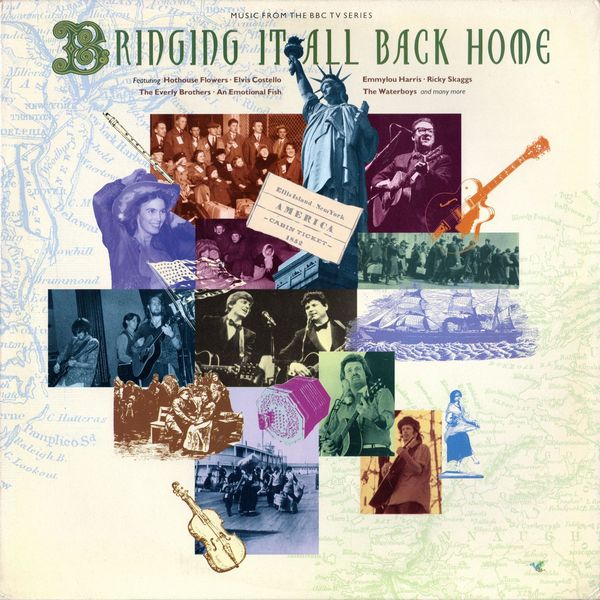 |

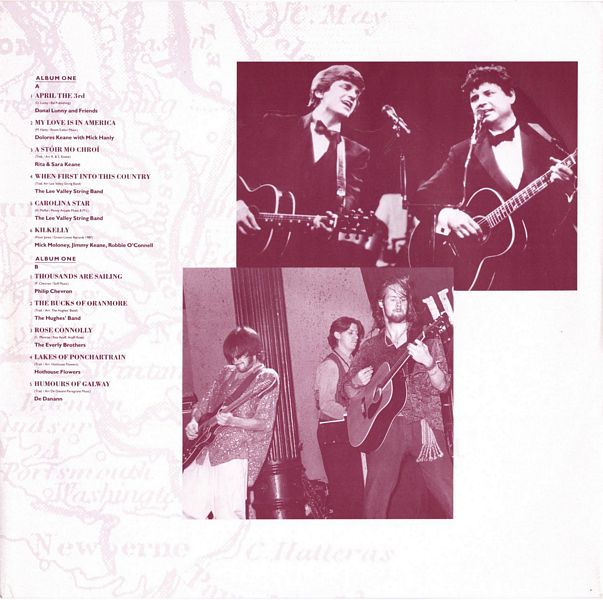
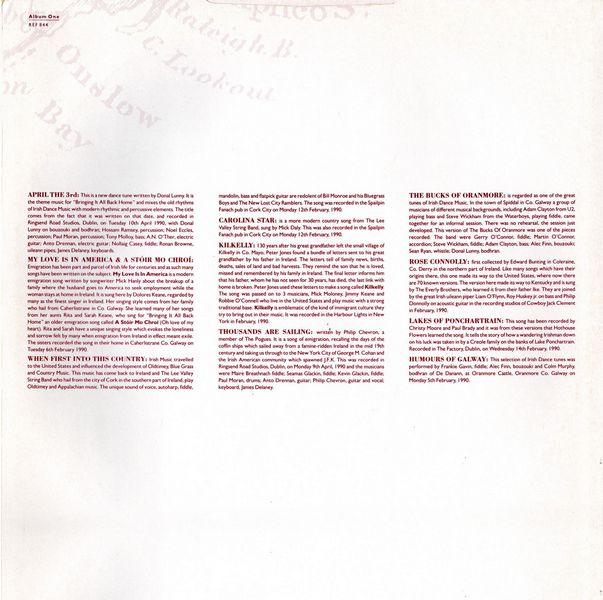
|
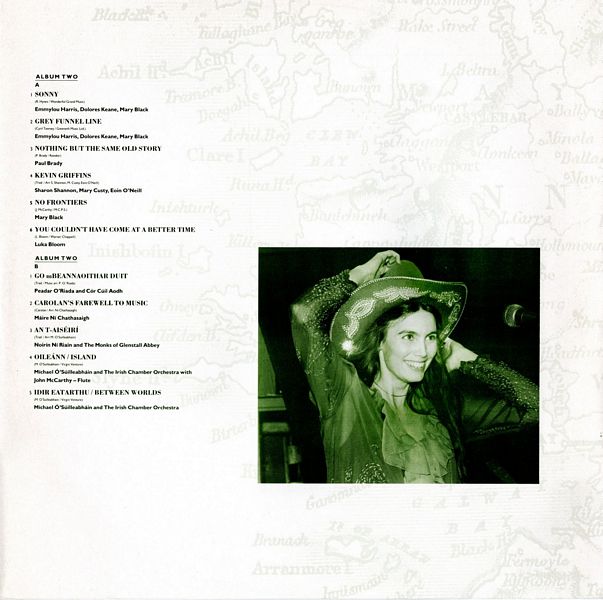
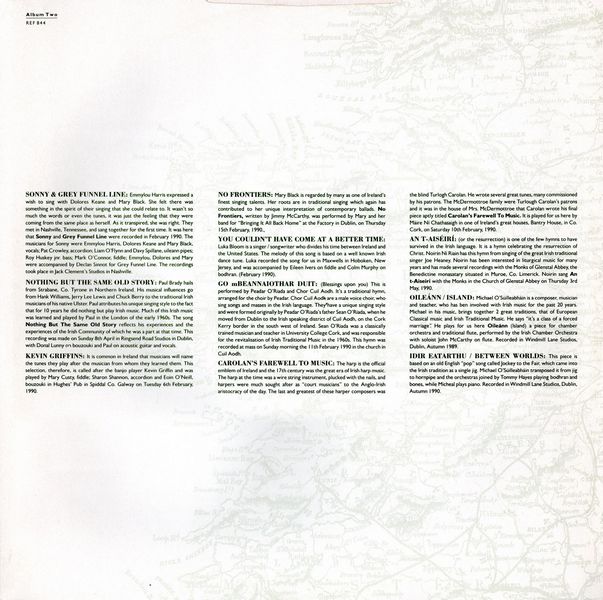
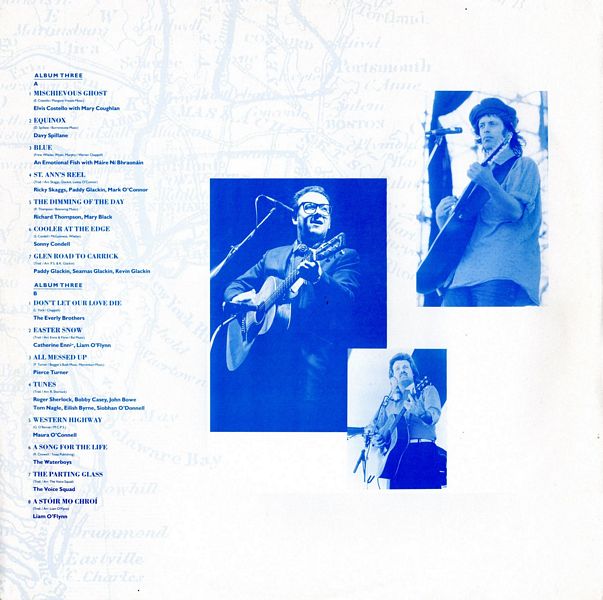

|
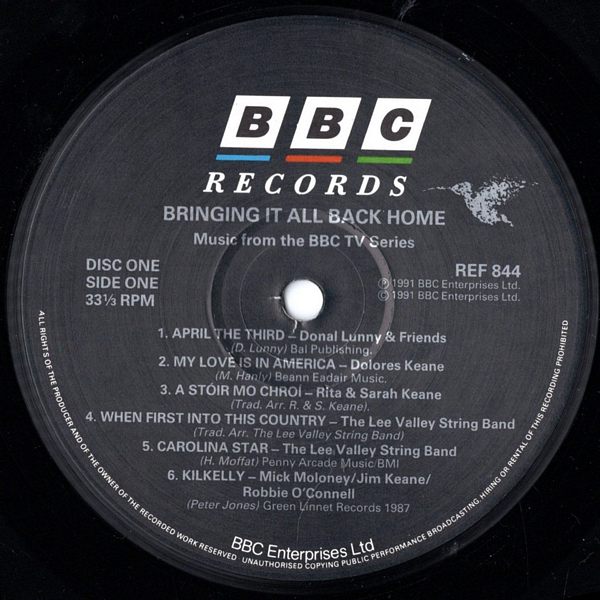
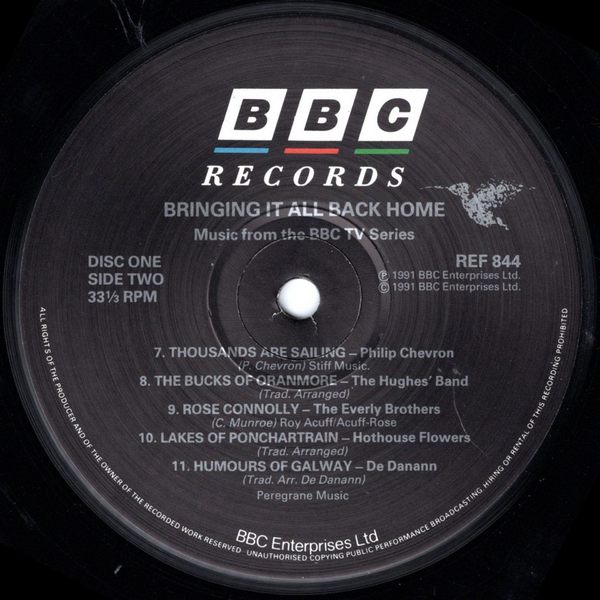
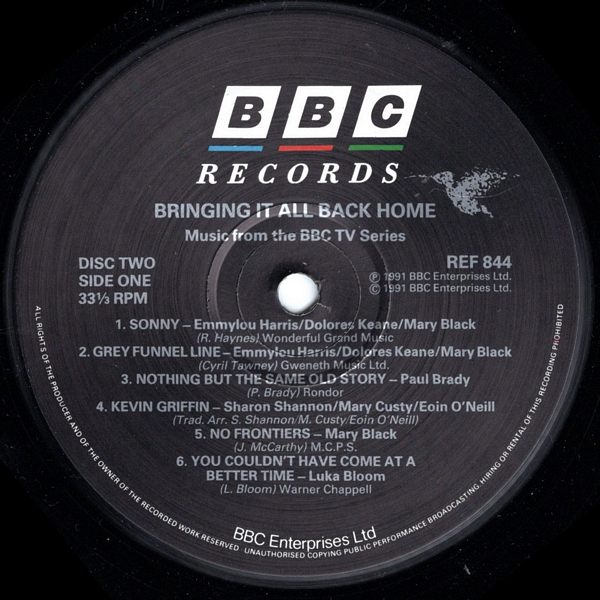
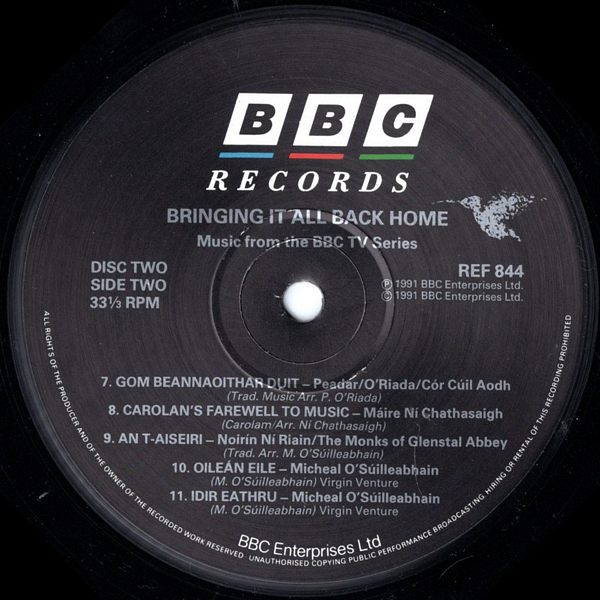
|
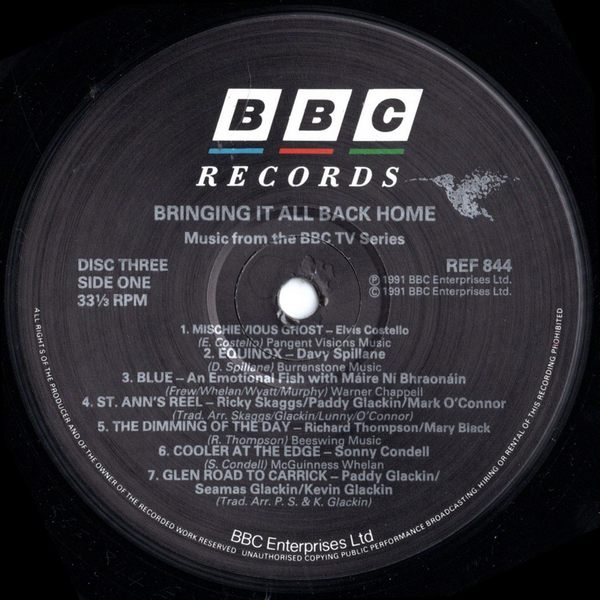

|
Sleeve Notes
For several centuries now, Irish music has been on the move, carried in the hands and voices of Irish people. Bringing It All Back Home attempts to chart some of its journeys; to go to some of the places reached, and to tell the story of how it inevitably wound its way back home again, as if to bear out that cyclical impulse at the heart of Irish artistic expression, the 'commodious vicus of recirculation' as Joyce thought of it.
The journeys undertaken were physical journeys — to America, England, and to a lesser extent Canada and Australasia. These waves of emigration began in the eighteenth century and have not yet receded. America is an important element in the story of Bringing It All Back Home. It was in America that the future development of Irish music, including traditional music, and indeed of American folk music was shaped.
Every living music undertakes a journey through time. But time is relative, and the journey of Irish music through time exemplifies this. On the one hand, traditional music changed very slowly, if at all. The culture it expressed remained much as it always had been … Irish-speaking, rural, and poor. Time was a commodity in plentiful supply and must have seemed to move slowly. So we get long songs of thirty verses and more to accommodate longer memories and an abundance of time. The spirit which animated this culture still lives on in parts of Ireland. As we shall see it was carried through the music into twentieth-century Ireland, changed, but recognisable. But in America, a new country, rapid change was the driving force, and Irish music absorbed this spirit of the new age, in order to re-invent itself, and meet the musical needs of the New World.
Dance music left Ireland in the heads, hands and feet of emigrants. In America its seductive rhythms influenced a host of diverse traditions, from Bluegrass to Country and Rock. Coming home on record, it proved fertile imaginative ground for a new generation of players who gradually realised the extraordinary richness of their own musical culture. Full circle....
Fed on a rich diet of emigrant dreams, bitter poverty and New World optimism, the Irish Ballad took root and flourished in America where it quickly found an appreciative audience. In the 1950s The Clancy Brothersperfected their style in the folk clubs of Greenwich Village where they met (and influenced) the young Bob Dylan. As so often happens, success abroad bred curiosity at home. The Clancys returned to Ireland in the 1960s.
It was inevitable that Irish Rock Musicians would begin to experiment with traditional Irish elements in their work. Inevitable too that the purists would grumble and the rockers yawn … at first. Because what started as a flirtation soon turned into a full blooded marriage of styles, with the emergence of Thin Lizzy, Sinéad O'Connor, The Waterboys, and one day along came "U" Know Who …
The twentieth-century influences of communications media and technology sent Irish music off in many different directions, towards rock, country, pop, electric folk, blues, and the avant-garde.
Old collections of the past also played a part in revitalising contemporary Irish music, particularly the classical tradition.
For Centuries Irish harp music flourished under the patronage of a wealthy aristocracy. 17th century Baroque music was also popular with the Irish nobility and an emerging middle class. These two traditions combined to produce a composer of extraordinary quality in Turlough O Carolan and his "Much Admired Old Tunes" have inspired generations of Irish (and not so Irish!) artists, from Seán O'Riada to the uncompromising father of the American Avant Garde, John Cage.
All of these Irish musical forms are offspring of the same traditional-music parent. They do not all co-exist happily together; some are regarded by others as bastards; some are at loggerheads; some are ignorant of their illustrious parentage. But they do share common features, not necessarily of musical construction, but of spirit, which identify them in some way as Irish.
Through the music, then, that has touched all of these generations, we can read the history of Ireland and her people, especially her emigrant people.
The traditional music of Ireland was the only enduring cultural baggage, intangible as it was, that impoverished emigrants could take out of the country.
In the past one hundred and fifty years Ireland has had more of its people leave the country than remain in it. This is unique in the history of emigration.
Being Irish outside Ireland is central to the Irish experience. As sociologist, Liam Ryan, recently wrote: 'Emigration is a mirror in which the Irish nation can see its true face! The question of identity for Irish people is fraught with ambivalence and tensions. Tensions come in the form of contradictory pressures — one to become assimilated into the new country, the other to affirm exclusive Irishness.
This music inevitable changed in the process of travel, sometimes to be unrecognisably transformed, sometimes evolving at the natural pace dedicated by the passing of time and a changing world. In places here and there, often on opposite sides of the globe, it remained almost untouched, a living, vibrant bridge to the past. Nor, as we shall see, was the traffic all one way.
Music returned to Ireland in many guises at different times, re-invigorating the tradition when it most needed it, Bringing It All Back Home — to the source and sensibility from which it had sprung.
Irish Music … Soul Music
'I have a theory that soul music originally came from Scotland and Ireland'.
VAN MORRISON
'that kind of stuff (Irish traditional music) I think comes directly from life … that kind of music springs directly uncensored from the soul of the people … it has no intellect that says I'd better do this or I'd better do that; it's soul music if you like'.
ELMER BERNSTEIN
APRIL THE 3rd: This is a new dance tune written by Dónal Lunny. It is the theme music for "Bringing It All Back Home" and mixes the old rhythms of Irish Dance Music with modern rhythmic and percussive elements. The title comes from the fact that it was written on that date, and recorded in Ringsend Road Studios, Dublin, on Tuesday 10th April 1990, with Dónal Lunny on bouzouki and bodhran; Hossam Ramsey, percussion; Noel Eccles, percussion; Paul Moran, percussion; Tony Molloy, bass; A.N. O'Ther, electric guitar; Anto Drennan, electric guitar, Nollaig Casey, fiddle; Ronan Browne, uileann pipes; James Delaney, keyboards.
MY LOVE IS IN AMERICA & A Ó MO CHROÍ: Emigration has been part and parcel of Irish life for centuries and as such many songs have been written on the subject My Love Is In America is a modern emigration song written by songwriter Mick Hanly about the breakup of a family where the husband goes to America to seek employment while the woman stays at home In Ireland. It is sung here by Dolores Keane, regarded by many as the finest singer in Ireland. Her singing style comes from her family who hail from Caherlistrane in Co. Galway. She learned many of her songs from her aunts Rita and Sarah Keane, who sing for "Bringing It All Back Home" an older emigration song called A Stóir Mo Chroí (Oh love of my heart). Rita and Sarah have a unique singing style which evokes the loneliness and sorrow felt by many when emigration from Ireland in effect meant exile. The sisters recorded the song in their home in Caherlistrane Co. Galway on Tuesday 6th February 1990.
WHEN FIRST INTO THIS COUNTRY: Irish Music travelled to the United States and influenced the development of Oldtimey, Blue Grass and Country Music. This music has come back to Ireland and The Lee Valley String Band who hail from the city of Cork in the southern part of Ireland, play Oldtimey and Appalachian music. The unique sound of voice, autoharp, fiddle, mandolin, bass and flatpick guitar are redolent of Bill Monroe and his Bluegrass Boys and The New Lost City Ramblers. The song was recorded in the Spailpin Fanach pub in Cork City on Monday 12th February, 1990.
CAROLINA STAR: is a more modern country song from The Lee Valley String Band, sung by Mick Daly. This was also recorded in the Spailpin Fanach pub in Cork City on Monday 12th February, 1990.
KILKELLY: 130 years after his great grandfather left the small village of Kilkelly in Co. Mayo, Peter Jones found a bundle of letters sent to his great grandfather by his father in Ireland. The letters tell of family news, births, deaths, sales of land and bad harvests. They remind the son that he is loved, missed and remembered by his family in Ireland. The final letter informs him that his father, whom he has not seen for 30 years, has died, the last link with home is broken. Peter Jones used these letters to make a song called Kilkelly. The song was passed on to 3 musicians, Mick Moloney, Jimmy Keane and Robbie O'Connell who live in the United States and play music with a strong traditional base. Kilkelly is emblematic of the kind of immigrant culture they try to bring out in their music. It was recorded in the Harbour Lights in New York in February, 1990.
THOUSANDS ARE SAILING: written by Philip Chevron, a member of The Pogues. It is a song of emigration, recalling the days of the coffin ships which sailed away from a famine-ridden Ireland in the mid 19th century and taking us through to the New York City of George M. Cohan and the Irish American community which spawned J.F.K. This was recorded in Ringsend Road Studios, Dublin, on Monday 9th April, 1990 and the musicians were Maire Breathnach fiddle; Seamas Glackin, fiddle; Kevin Glackin, fiddle; Paul Moran, drums; Anto Drennan, guitar; Philip Chevron, guitar and vocal; keyboard, James Delaney.
THE BUCKS OF ORANMORE: is regarded as one of the great tunes of Irish Dance Music. In the town of Spiddal in Co. Galway a group of musicians of different musical backgrounds, including Adam Clayton from U2, playing bass and Steve Wickham from the Waterboys, playing fiddle, came together for an informal session. There was no rehearsal, the session just developed. This version of The Bucks Of Oranmore was one of the pieces recorded. The band were Gerry O'Connor, fiddle; Máirtín O Connor, accordion; Steve Wickham, fiddle; Adam Clayton, bass; Alec Finn, bouzouki; Seán Ryan, whistle; Dónal Lunny, bodhran.
ROSE CONNOLLY: first collected by Edward Bunting in Coleraine, Co. Derry in the northern part of Ireland. Like many songs which have their origins there, this one made its way to the United States, where now there are 70 known versions. The version here made its way to Kentucky and is sung by The Everly Brothers, who learned it from their father Ike. They are joined by the great Irish uileann piper Liam O'Flynn, Roy Huskey Jr. on bass and Philip Donnolly on acoustic guitar in the recording studios of Cowboy Jack Clement in February, 1990.
LAKES OF PONCHARTRAIN: This song has been recorded by Christy Moore and Paul Brady and it was from these versions that Hothouse Flowers learned the song. It tells the story of how a wandering Irishman down on his luck was taken in by a Creole family on the banks of Lake Ponchartrain. Recorded in The Factory, Dublin, on Wednesday 14th February, 1990.
HUMOURS OF GALWAY: This selection of Irish Dance tunes was performed by Frankie Gavin, fiddle; Alec Finn, bouzouki and Colm Murphy, bodhran of De Danann, at Oranmore Castle, Oranmore Co. Galway on Monday 5th February, 1990.
SONNY & GREY FUNNEL LINE: Emmylou Harris expressed a wish to sing with Dolores Keane and Mary Black. She felt there was something in the spirit of their singing that she could relate to. It wasn't so much the words or even the tunes, it was just the feeling that they were coming from the same place as herself. As it transpired, she was right. They met in Nashville, Tennessee, and sang together for the first time. It was here that Sonny and Grey Funnel Line were recorded in February 1990. The musicians for Sonny were Emmylou Harris, Dolores Keane and Mary Black, vocals; Pat Crowley, accordion; Liam O'Flynn and Davy Spillane, uileann pipes; Roy Huskey Jr. bass; Mark O'Connor, fiddle; Emmylou, Dolores and Mary were accompanied by Declan Sinnot for Grey Funnel Line. The recordings took place in Jack Clement's Studios in Nashville.
NOTHING BUT THE SAME OLD STORY: Paul Brady hails from Strabane, Co. Tyrone in Northern Ireland. His musical influences go from Hank Williams, Jerry Lee Lewis and Chuck Berry to the traditional Irish musicians of his native Ulster. Paul attributes his unique singing style to the fact that for 10 years he did nothing but play Irish music. Much of this Irish music was learned and played by Paul in the London of the early 1960s. The song Nothing But The Same Old Story reflects his experiences and the experiences of the Irish Community of which he was a part at that time. This recording was made on Sunday 8th April in Ringsend Road Studios in Dublin, with Dónal Lunny on bouzouki and Paul on acoustic guitar and vocals.
KEVIN GRIFFINS: It is common in Ireland that musicians will name the tunes they play after the musician from whom they learned them. This selection, therefore, is called after the banjo player Kevin Griffin and was played by Mary Custy, fiddle; Sharon Shannon, accordion and Eoin O'Neill, bouzouki in Hughes' Pub in Spiddal Co. Galway on Tuesday 6th February, 1990.
NO FRONTIERS: Mary Black is regarded by many as one of Ireland's finest singing talents. Her roots are in traditional singing which again has contributed to her unique interpretation of contemporary ballads. No Frontiers, written by Jimmy McCarthy, was performed by Mary and her band for "Bringing It All Back Home” at the Factory in Dublin, on Thursday 15th February, 1990.,
YOU COULDN'T HAVE COME AT A BETTER TIME: Luka Bloom is a singer/songwriter who divides his time between Ireland and the United States. The melody of this song is based on a well known Irish dance tune. Luka recorded the song for us in Maxwells in Hoboken, New Jersey, and was accompanied by Eileen Ivers on fiddle and Colm Murphy on bodhran. (February 1990).
GO mBEANNAIOTHAR DUIT: (Blessings upon you) This is performed by Peadar O'Riada and Chor Cuil Aodh. It's a traditional hymn, arranged for the choir by Peadar. Chor Cuil Aodh are a male voice choir, who sing songs and masses In the Irish language. They have a unique singing style and were formed originally by Peadar O'Riada's father Seán O'Riada, when he moved from Dublin to the Irish speaking district of Cuil Aodh, on the Cork Kerry border in the south west of Ireland. Seán O'Riada was a classically trained musician and teacher in University College Cork, and was responsible for the revitalisation of Irish Traditional Music in the 1960s. This hymn was recorded at mass on Sunday morning the 11th February 1990 in the church in Cuil Aodh.
CARDIGAN'S FAREWELL TO MUSIC: The harp is the official emblem of Ireland and the 17th century was the great era of Irish harp music. The harp at the time was a wire string instrument, plucked with the nails, and harpers were much sought after as "court musicians” to the Anglo-Irish aristocracy of the day. The last and greatest of these harper composers was the blind Turlogh Carolan. He wrote several great tunes, many commissioned by his patrons. The McDermottroe family were Turlough Cardan's patrons and it was in the house of Mrs. McDermottroe that Carolan wrote his final piece aptly titled Carolan's Farewell To Music. It is played for us here by Máire Ní Chathasaigh in one of Ireland's great houses, Bantry House, in Co. Cork, on Saturday 10th February, 1990.
AN T-AISÉIRÍ: (or the resurrection) is one of the few hymns to have survived in the Irish language. It is a hymn celebrating the resurrection of Christ. Noirín Ní Riain has this hymn from singing of the great Irish traditional singer Joe Heaney. Noirín has been interested in liturgical music for many years and has made several recordings with the Monks of Glenstal Abbey, the Benedictine monasatary situated in Muroe, Co. Limerick. Noirín sang An t-Aiseiri with the Monks in the Church of Glenstal Abbey on Thursday 3rd May, 1990.
OILEÁNN (ISLAND): Michael O'Súilleabháin is a composer, musician and teacher, who has ben involved with Irish music for the past 20 years. Michael in his music, brings together 2 great traditions, that of European Classical music and Irish Traditional Music. He says "it's a class of a forced marriage". He plays for us here Oileánn (Island) a piece for chamber orchestra and traditional flute, performed by the Irish Chamber Orchestra with soloist John McCarthy on flute. Recorded in Windmill Lane Studios, Dublin, Autumn 1989.
IDIR EATARTHU (BETWEEN WORLDS): This piece is based on an old English "pop” song called Jockey to the Fair, which came into the Irish tradition as a single jig. Michael O'Súilleabhain transposed it from jig to hornpipe and the orchestras joined by Tommy Hayes playing bodhran and bones, while Micheal plays piano. Recorded in Windmill Lane Studios, Dublin, Autumn 1990.
MISCHIEVOUS GHOST: written especially for "Bringing It All Back Home" by Elvis Costello. It features a string sextet, 2 violins, 2 cellos, and 2 violas, arranged by Fiachra Trench, with Dónal Lunny on bodhran, Davy Spillane on uileann pipes, Mary Coughlan vocals, and Elvis Costello lead vocal and 12 string guitar. Musically, according to Elvis Costello, Mischievous Ghost is a "collision between a discipline like chamber music and a melody derived somewhat from traditional music". Recorded in Ringsend Road Studios, Dublin on Thursday 12th April, 1990.
EQUINOX: Davy Spillane plays his own composition with Albert Lee on electric guitar, Ross Barenberg on acoustic guitar, Roy Huskey Jr. on acoustic bass, Mark O'Connor on mandolin. It was recorded in Cowboy Jack Clement's Studios in Nashville in February 1990. Davy Spillane uses uileann pipes and low whistle. The source of his inspiration for this haunting ethereal piece of music is found in the melodic conventions of the playing of Irish song airs.
BLUE: Dublin's Rock band An Emotional Fish are joined by Máire Ní Bhraonain from the world famous group Clannad for this version of their original song Blue recorded on Thursday 15th February, 1990 at The Factory, Dublin.
ST. ANN'S REEL: Irish dance music made its way to America and became a major influence on Appalachian Dance music. Ricky Skaggs credits the Appalachian "high lonesome sound", where dance music is shot through with a certain sadness, to the fact that even several generations later the music was remembering where it came from. Country music's most famous multi-instrumentalist Skaggs is joined here by Irish fiddle player Paddy Glackin and American fiddle player Mark O'Connor, in a driving version of St. Ann's Reel, followed by The Blackberry Blossom, tunes which are found both in Ireland and in the United States. Recorded in February 1990 in Cowboy jack Clement's Studios in Nashville, they are joined by Roy Huskey Jr. on bass, Russ Barenberg on guitar and Dónal Lunny on bouzouki.
THE DIMMING OF THE DAY: Richard Thompson was a founder member of Fairport Convention, one of the first electric folk bands to popularise traditional songs and dance tunes and bring them to a new audience. Richard Thompson is arguably one of the world's great song writers. He first recorded The Dimming of the Day on the 1975 Richard and Linda Thompson album "Pour Down Like Silver". This version was recorded in February 1990 at Jack Clement's Studios in Nashville with Mary Black and Dolores Keane adding vocal harmonies. Declan Sinnot on guitar, Pat Crowley on accordion, Roy Huskey Jr. on bass.
COOLER AT THE EDGE: is a modern emigrant song written by Sonny Condell in jig time. It has a distinctly Irish flavour while at the same time adopting an imaginative modern musical approach. It was recorded in Ringsend Road Studios on Friday 6th April, 1990 with Garven Gallagher on bass, Paul Moran, drums and percussion; Pat Crowley, accordion; Robbie Oversion, guitar; Maggie Cody, backing vocals and Sonny Condell, vials and guitar.
GLEN ROAD TO GARRICK: John Doherty was a travelling fiddle player from Co. Donegal on the northwest coast of Ireland. His playing has influenced a generation of Donegal fiddlers. Paddy Glackin, whose father came from Donegal, met John Doherty at an early age and learned much of his music from him. Here Paddy and his brother Seamas and Kevin play 2 tunes The Glen Road To Carrick and The Wild Irish Man, both favourites of John Doherty's. Recorded on Monday 9th April, 1990 in Ringsend Road Studios, Dublin.
DON'T LET OUR LOVE DIE: Don and Phil Everly began singing with their mom and dad at a very early age. Their father Ike had a great big song book with hundreds of songs and as Don says with a tinge of regret "we never asked him where the songs came from, but? I guess many of them must have come with the settlers" The Everly Brothers have been singing Don't Let Our Love Die for many years. It doesn't have any identifiable Irish root, but again there's something in the harmony singing that remembers the old country. The harmonies and the pipes together see a blending of 2 styles to give us a new and exciting sound. Recorded in Jack Clement's Studios in Nashville on Thursday 12th April, 1990.
EASTER SNOW: was one of the favourite tunes of the late uileann piper Seamas Ennis. It is played for us here by his daughter Catherine Ennis on organ and Liam O'Flynn on uileann pipes. Catherine loves the effect of these instruments playing together "....it's like having a stop but a sort of human stop rather than just a series of organ pipes". Recorded in the church in Glenstal Abbey, Co. Limerick on Thursday 3rd May, 1990.
ALL MESSED UP: Pierce Turner comes from Co. Wexford and now lives in New York City. He has worked closely with the composer Philip Glass but has never lost touch with the music of his native Ireland. The melody which he plays on piano is constructed around a traditional Irish song "Seán O Duibhir an ghleanne" (Seán O'Dwyer of the glen) one of the oldest Irish song airs. Here Pierce is joined by Anto Drennan on guitar, Cormac Breathnach on whistle and it was recorded in Ringsend Road Studios Dublin on Wednesday 11th April, 1990.
TUNES: Roger Sherlock left his native Sligo for London in 1952 and has lived there ever since. Roger is to be found regularly playing Irish Music in the White Hart pub in Fulham. He is a very important figure in the London Irish musical community, in that he carries with him his unique style and the tunes of his native Co. Sligo, one of the most important musical counties in Ireland. This selection of tunes was recorded for "Bringing It All Back Home" in the White Hart on Tuesday 27th March, 1990.
WESTERN HIGHWAY: Maura O'Connell comes from Co. Clare on the west coast of Ireland. She began her musical career singing with the group De Danann. She has recorded 4 solo albums and now lives in Nashville. Western Highway was written by Gerry O'Beirne and was recorded in Westland Studios in Dublin on 11th May, 1990, with Arty McGlynn on guitar, and Nollaig Casey on fiddle.
SONG FOR THE LIFE: During the recording of their album "Room to Roam" The Waterboys took time out to record this Rodney Crowell song at Spiddal House, Spiddal Co. Galway on Saturday 5th May, 1990. The Waterboys on this record are: Trevor Hutchinson on bass, Nollaig Bridgeman on drums, Colin Blakey on hammond organ, Steve Wickham on fiddle, Sharon Shannon on accordion, Anto Thistlethwaite on tenor sax, and Mike Scott, vocal and guitar.
THE PARTING GLASS: Unaccompanied singing is a great part of the Irish tradition. The Voice Squad, Fran McPhail, Phil Callery and Gerry Cullen, are making sure that the tradition will never die. They seek out and collect songs from all parts of the country and from England and treat them in their unique way. As they say themselves, they save songs from extinction. The Parting Glass, a poignant ballad of parting, was sung for us in 3 part harmony and recorded at the Factory in Dublin on Thursday 15th February, 1990.
A STÓIR MO CHROÍ: This is the instrumental version of the song sung by Rita and Sarah Keane of Caherlistrane in Co. Galway. It is played for us here with great emotion by uileann piper Liam O'Flynn. The uileann pipes suit the desolate mood of the air. Recorded in Bantry House, Co. Cork, on Saturday 10th February, 1990.